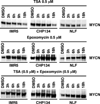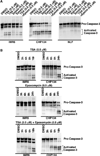Biological effects of induced MYCN hyper-expression in MYCN-amplified neuroblastomas
- PMID: 20811720
- PMCID: PMC3212990
- DOI: 10.3892/ijo_00000749
Biological effects of induced MYCN hyper-expression in MYCN-amplified neuroblastomas
Abstract
Neuroblastoma is a childhood malignancy of the sympathetic nervous system. The tumor exhibits two different phenotypes: favorable and unfavorable. MYCN amplification is associated with rapid tumor progression and the worst neuroblastoma disease outcome. We have previously reported that inhibitors of histone deacetylase (HDAC) and proteasome enhance favorable neuroblastoma gene expression in neuroblastoma cell lines and inhibit growth of these cells. In this study, we investigated the effect of trichostatin A or TSA (an HDAC inhibitor), and epoxomycin (a proteasome inhibitor) on MYCN and p53 expression in MYCN-amplified neuroblastoma cells. It was found that TSA down-regulated MYCN expression, but Epoxomycin and the TSA/Epoxomycin combination led to MYCN hyper-expression in MYCN-amplified neuroblastoma cell lines. Despite their contrasting effects on MYCN expression, TSA and Epoxomycin caused growth suppression and cell death of the MYCN-amplified cell lines examined. Consistent with these data, forced hyper-expression of MYCN in MYCN-amplified IMR5 cells via transfection resulted in growth suppression and the increased expression of several genes known to suppress growth or induce cell death. Furthermore, Epoxomycin as a single agent and its combination with TSA enhance p53 expression in the MYCN-amplified neuroblastoma cell lines. Unexpectedly, co-transfection of TP53 and MYCN in IMR5 cells resulted in high p53 expression but a reduction of MYCN expression. Together our data suggest that either down regulation or hyper-expression of MYCN results in growth inhibition and/or apoptosis of MYCN-amplified neuroblastoma cells. In addition, elevated p53 expression has a suppressive effect on MYCN expression in these cells.
Figures









References
-
- Moreau LA, McGrady P, London WB, Shimada H, Cohn SL, Maris JM, Diller L, Look AT, George RE. Does MYCN amplification manifested as homogeneously staining regions at diagnosis predict a worse outcome in children with neuroblastoma? A Children's Oncology Group study. Clin Cancer Res. 2006;12:5693–5697. - PubMed
-
- Seeger RC, Brodeur GM, Sather H, Dalton A, Siegel SE, Wong KY, Hammond D. Association of multiple copies of the N-myc oncogene with rapid progression of neuroblastomas. New Engl J Med. 1985;313:1111–1116. - PubMed
-
- Brodeur GM, Seeger RC, Schwab M, Varmus HE, Bishop JM. Amplification of N-myc in untreated human neuroblastomas correlates with advanced disease stage. Science. 1984;224:1121–1124. - PubMed
-
- Thiele CJ, Reynolds CP, Israel MA. Decreased expression of N-myc precedes retinoic acid-induced morphological differentiation of human neuroblastoma. Nature. 1985;313:404–406. - PubMed
Publication types
MeSH terms
Substances
Grants and funding
LinkOut - more resources
Full Text Sources
Medical
Research Materials
Miscellaneous

